12.10 Life Turns
Are you prepared for life turns-unexpected calamities, tragedies, good fortune, and a hope that a better future can be secured? What life turns and “marker events” stand out for you as memorable and life-altering in some way? Birth, war and conflict, death, marriage, separation, a move to a new town or city, adapting to a new job, having children (or the absence of these) can be disorienting dilemmas that cause individuals to challenge their belief systems. Coping with life-altering marker events may be a combination of personality hardiness and environmental factors that provide resources for individuals to overcome challenges and hardships in life. The search for identity and meaning in life amid adversity can be filled with uncertainty and anxiety. In this section, artists and poets present visions of a world and life experiences that seem daunting, harrowing, and perhaps unexpected.
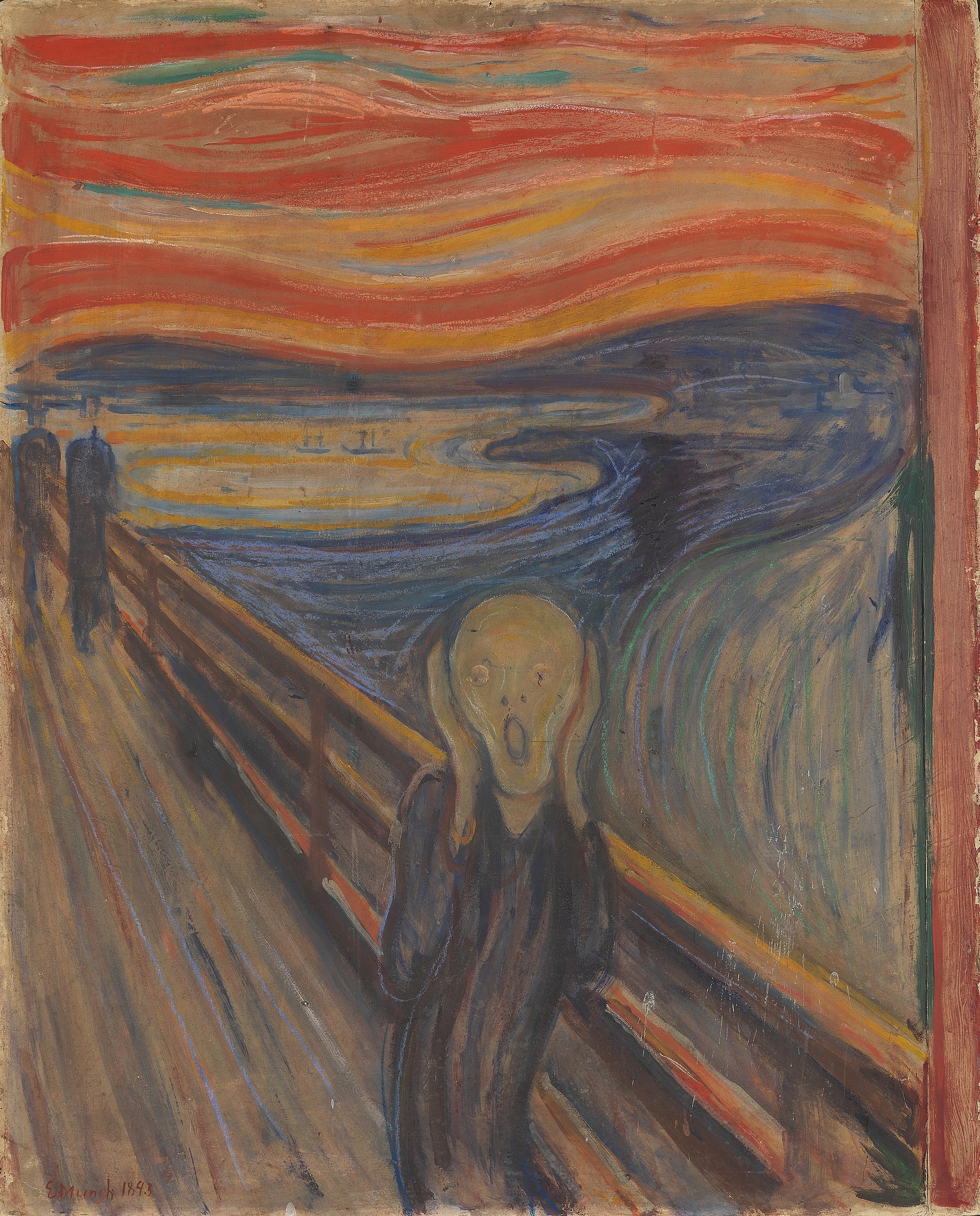
Courtesy: By Edvard Munch – National Gallery of Norway 8 January 2019 (upload date) by Coldcreation, Public Domain, https://commons.wikimedia.org/w/index.php?curid=69541493
“City Life” by D. H. Lawrence
“When I am in a great city, I know that I despair.
I know there is no hope for us, death waits, it is useless to care.
For oh the poor people, that are flesh of my flesh,
I, that am flesh of their flesh,
when I see the iron hooked into their faces
their poor, their fearful faces
I scream in my soul, for I know I cannot
take the iron hook out of their faces, that makes them so drawn,
nor cut the invisible wires of steel that pull them
back and forth, to work,
back and forth, to work,
like fearful and corpse-like fishes hooked and being played
by some malignant fisherman on an unseen shore
where he does not choose to land them yet, hooked fishes of the factory world.”
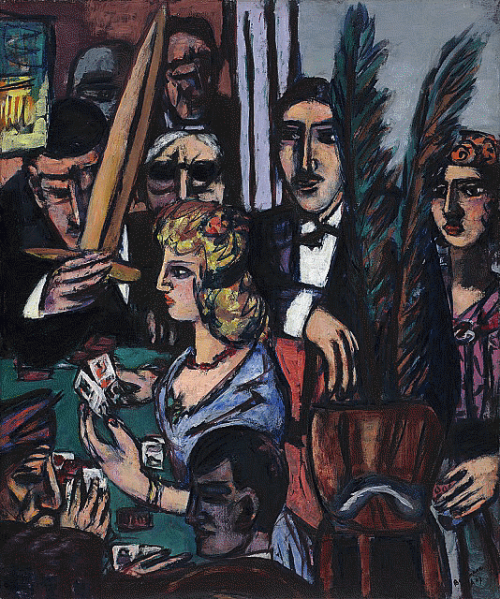
Courtesy: By Max Beckmann – https://art.nelson-atkins.org/objects/21087/, Public Domain, https://commons.wikimedia.org/w/index.php?curid=98503876
Additional Resources
Audio Recording of City Life by D. H. Lawrence:
Collected Poems of D. H. Lawrence.
“The World is a Beautiful Place” by Lawrence Ferlingetti
“London” by William Blake (1757–1827)
I wander thro’ each charter’d street,
Near where the charter’d Thames does flow.
And mark in every face I meet
Marks of weakness, marks of woe.
In every cry of every Man,
In every Infants cry of fear,
In every voice: in every ban,
The mind-forg’d manacles I hear
How the Chimney-sweepers cry
Every blackning Church appalls,
And the hapless Soldiers sigh
Runs in blood down Palace walls
But most thro’ midnight streets I hear
How the youthful Harlots curse
Blasts the new-born Infants tear
And blights with plagues the Marriage hearse.
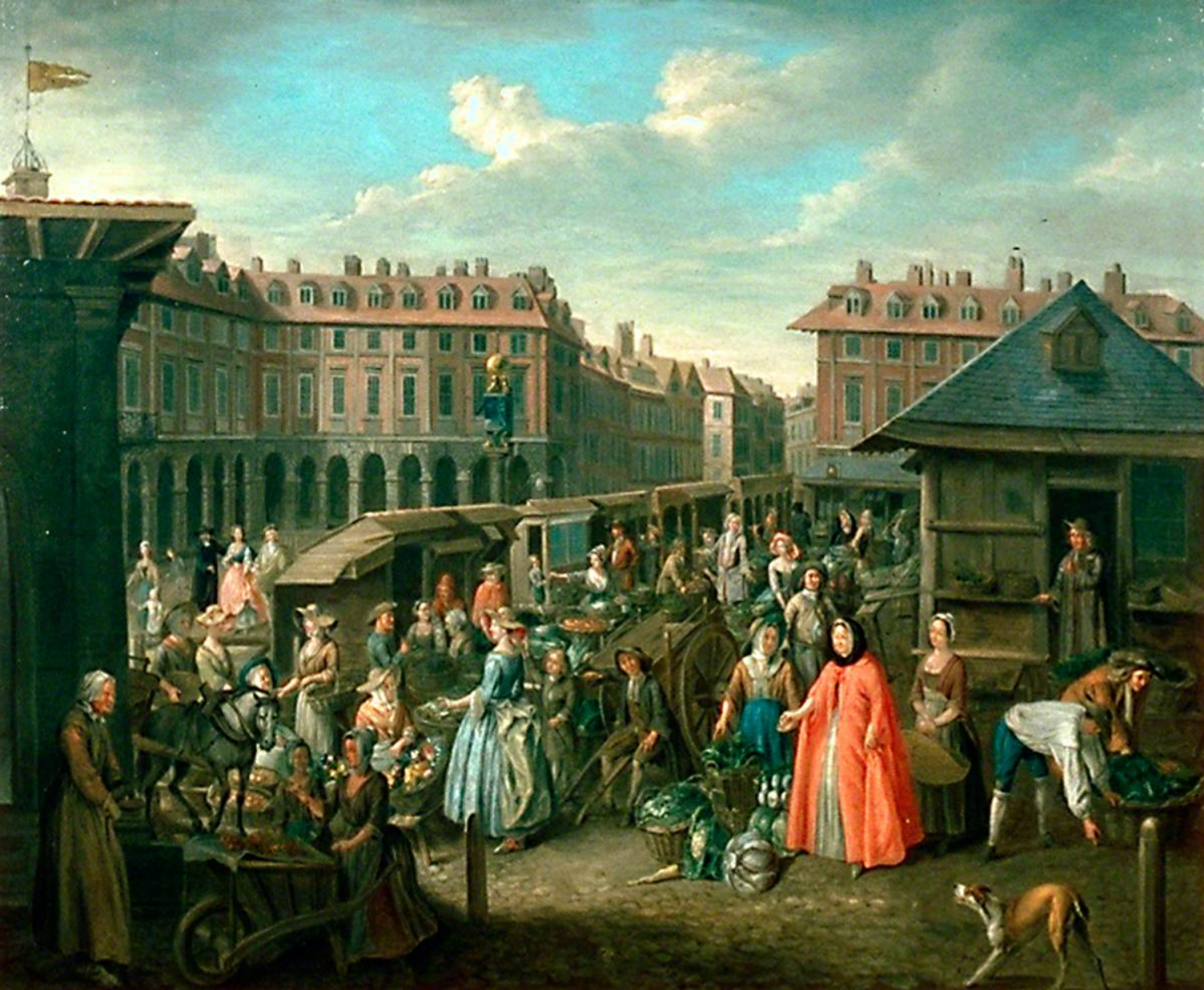
Courtesy: By Joseph Van Aken – https://artuk.org/discover/artworks/old-covent-garden-27583, Public Domain, https://commons.wikimedia.org/w/index.php?curid=116561023
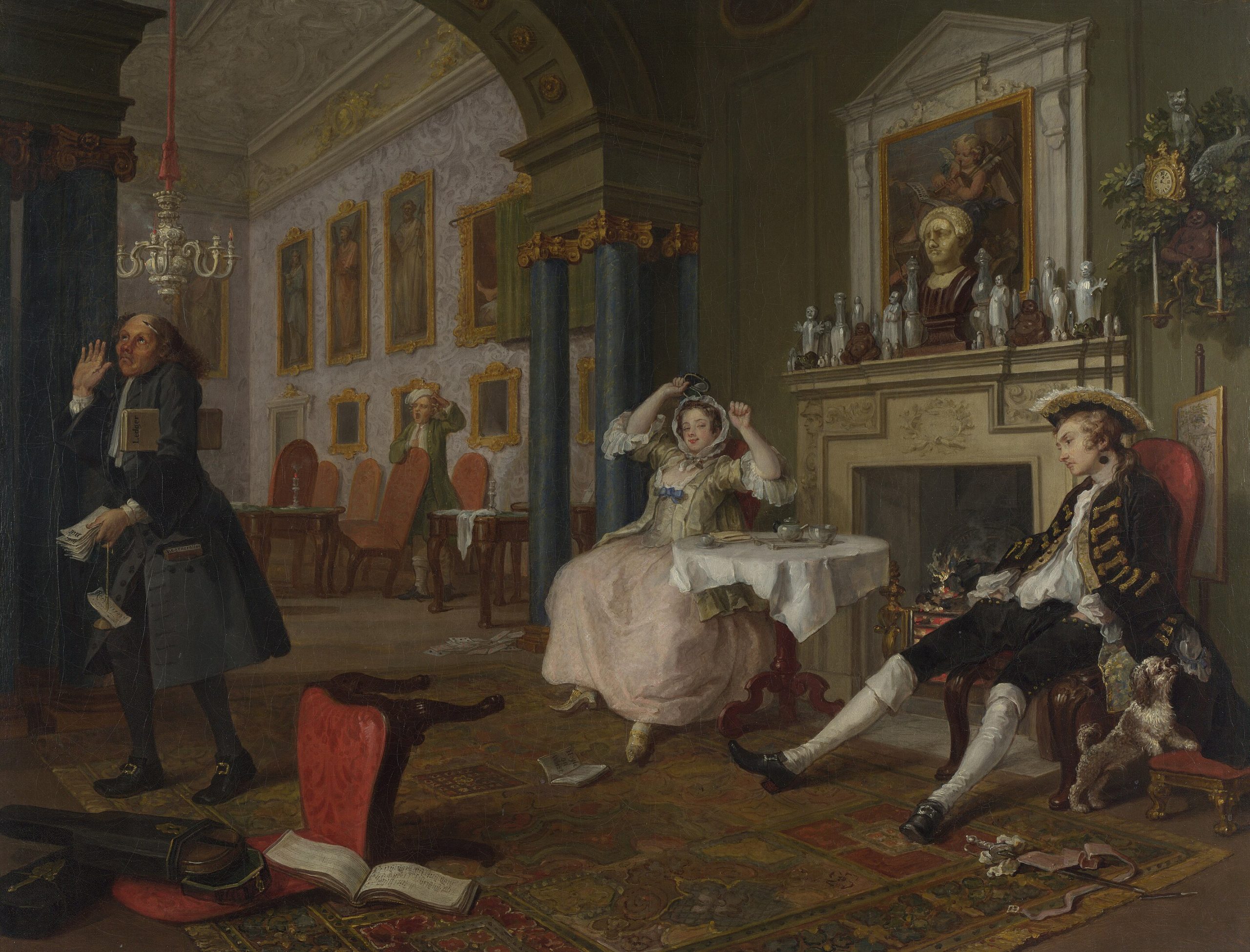
Courtesy: By William Hogarth – The National Gallery, Public Domain, https://commons.wikimedia.org/w/index.php?curid=38101402
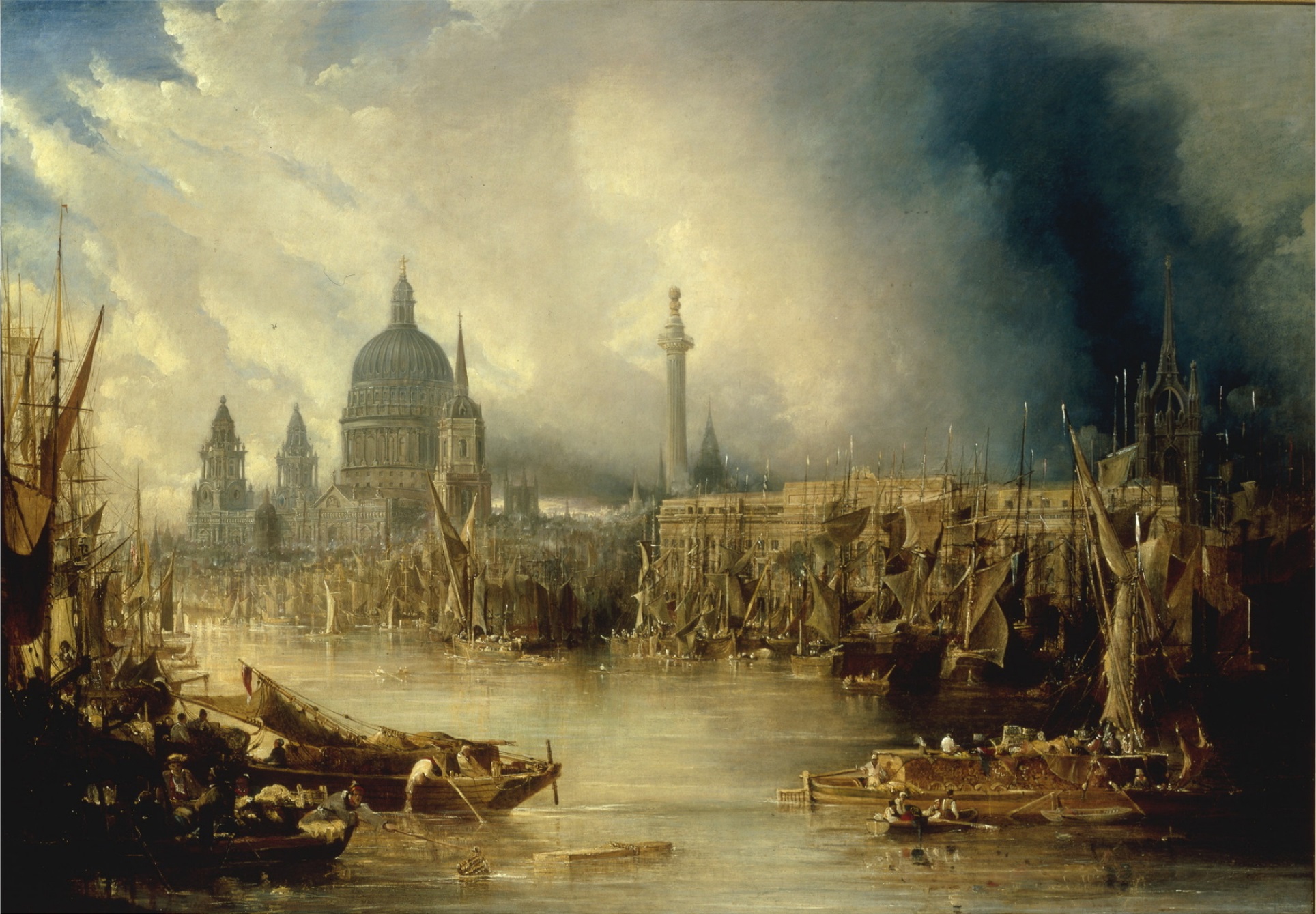
Courtesy: By John Gendall – Bridgeman Art Library: Object 989936, Public Domain, https://commons.wikimedia.org/w/index.php?curid=32009654
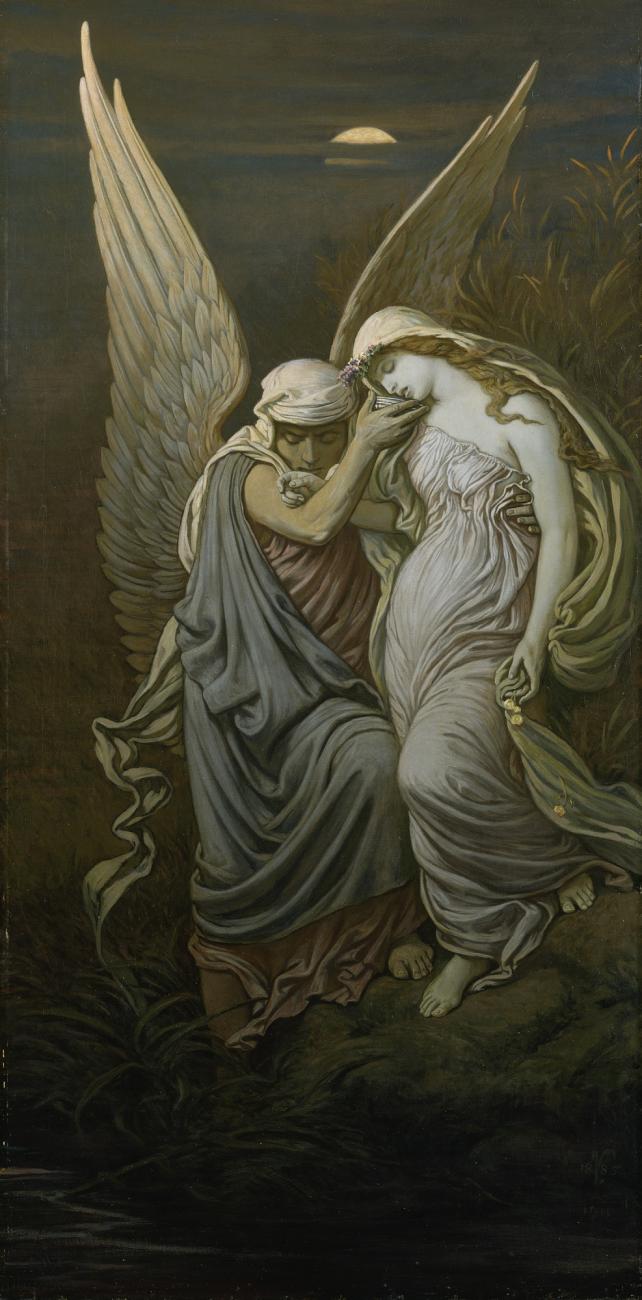
Elihu Vedder (1836-1923). The Cup of Death (1885/1911). Smithsonian American Art Museum, Washington, D.C., United States. Public Domain. Courtesy: By Elihu Vedder – https://americanart.si.edu/artwork/cup-death-25624, Public Domain, https://commons.wikimedia.org/w/index.php?curid=69439441
“Do not go gentle into that good night“ by Dylan Thomas
Do not go gentle into that good night,
Old age should burn and rave at close of day;
Rage, rage against the dying of the light.
Though wise men at their end know dark is right,
Because their words had forked no lightning they
Do not go gentle into that good night.
Good men, the last wave by, crying how bright
Their frail deeds might have danced in a green bay,
Rage, rage against the dying of the light.
Wild men who caught and sang the sun in flight,
And learn, too late, they grieved it on its way,
Do not go gentle into that good night.
Grave men, near death, who see with blinding sight
Blind eyes could blaze like meteors and be gay,
Rage, rage against the dying of the light.
And you, my father, there on the sad height,
Curse, bless, me now with your fierce tears, I pray.
Do not go gentle into that good night.
Rage, rage against the dying of the light.
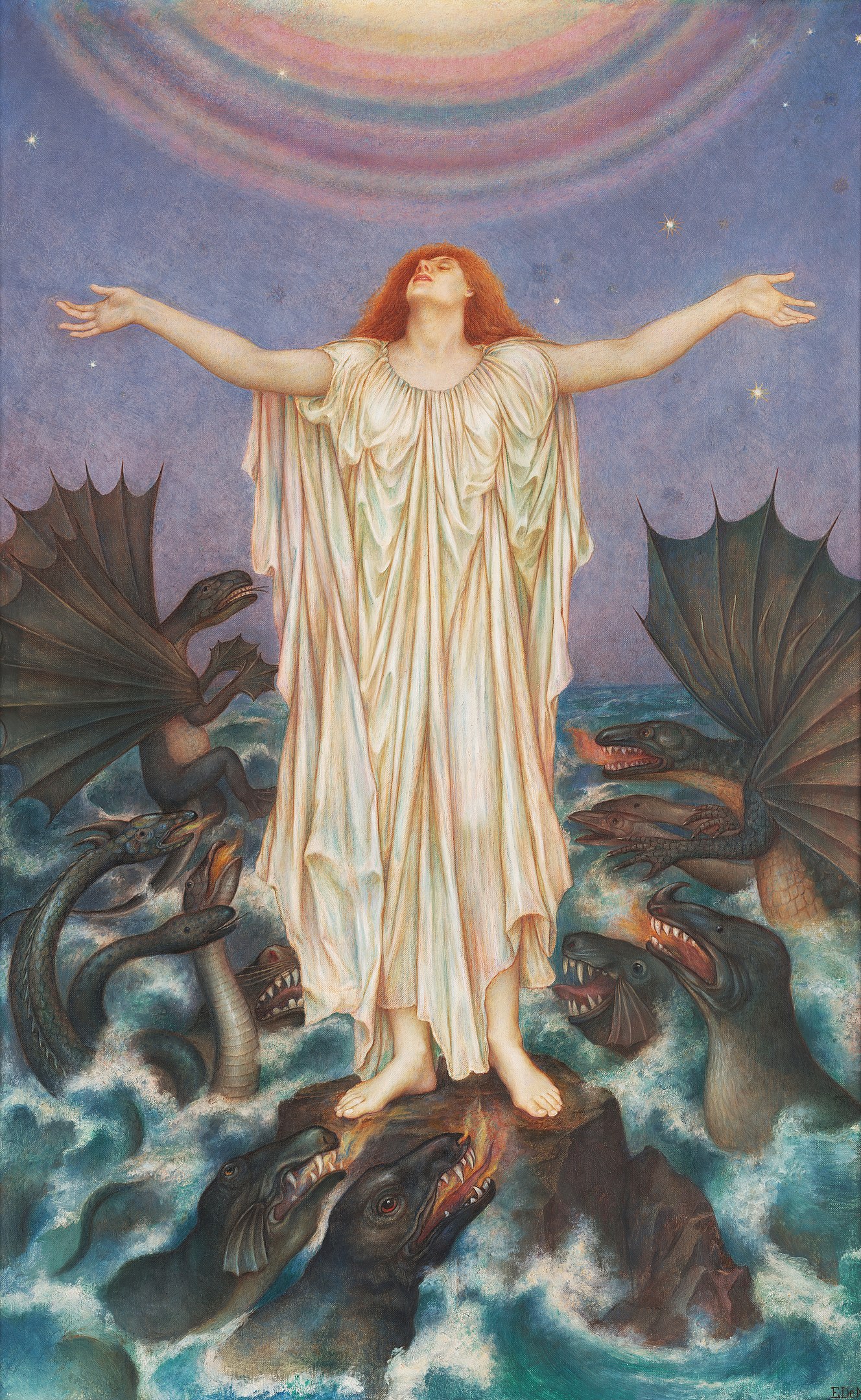
Courtesy: By Evelyn De Morgan – [1] and [2], Public Domain, https://commons.wikimedia.org/w/index.php?curid=30643317
“No Man is an Island” by John Donne
No man is an island,
Entire of itself;
Every man is a piece of the continent,
A part of the main.
If a clod be washed away by the sea,
Europe is the less,
As well as if a promontory were:
As well as if a manor of thy friend’s
Or of thine own were.
Any man’s death diminishes me,
Because I am involved in mankind.
And therefore never send to know for whom the bell tolls;
It tolls for thee..
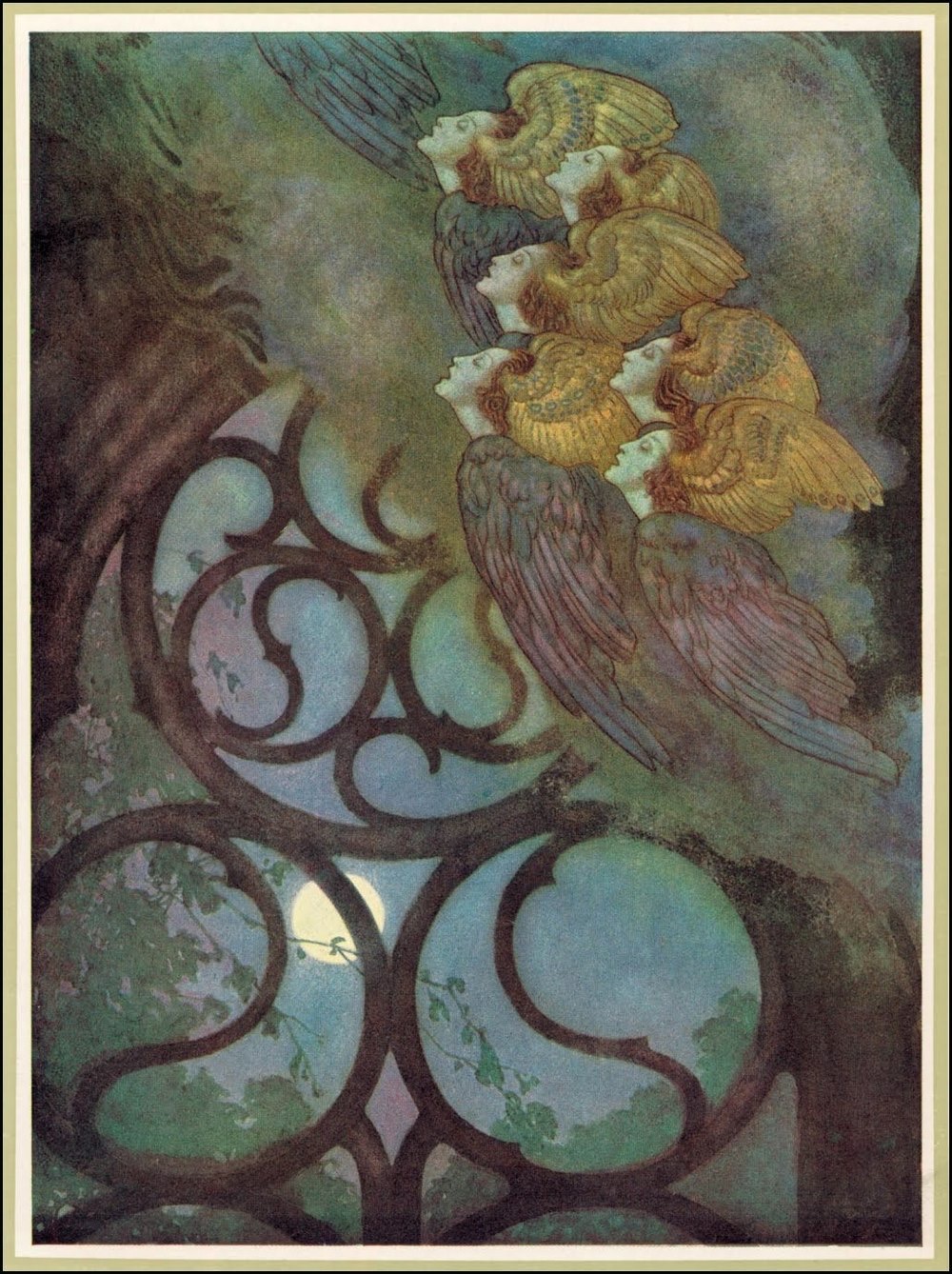
Courtesy: Poe, Edgar Allan. (Jan 5, 2016). The Bells and Other Poems. Project Gutenberg (Public Domain). Retrieved March 10, 2023, from https://www.gutenberg.org/files/50852/50852-h/50852-h.htm
“The Bells“ by Edgar Allan Poe
Hear the loud alarum bells—
Brazen bells!
What a tale of terror, now, their turbulency tells!
In the startled ear of night
How they scream out their affright!
Too much horrified to speak
They can only shriek, shriek,
Out of tune,
In a clamorous appealing to the mercy of the fire,
In a mad expostulation with the deaf and frantic fire,
Leaping higher, higher, higher,
With a desperate desire,
And a resolute endeavour.
Now—now to sit or never,
By the side of the pale-faced moon.
Oh, the bells, bells, bells!
What a tale their terror tells
Of Despair!
How they clang, and clash, and roar!
What a horror they outpour
On the bosom of the palpitating air!
Yet the ear it fully knows,
By the twanging,
And the clanging,
How the danger ebbs and flows:
Yet the ear distinctly tells,
In the jangling,
And the wrangling,
How the danger sinks and swells,
By the sinking or the swelling in the anger of the bells—
Of the bells—
Of the bells, bells, bells, bells,
Bells, bells, bells—
In the clamour and the clangour of the bells!
(For the complete poem, please open the link below:
Narratives and Ballads
Mysteries and the Uncanny
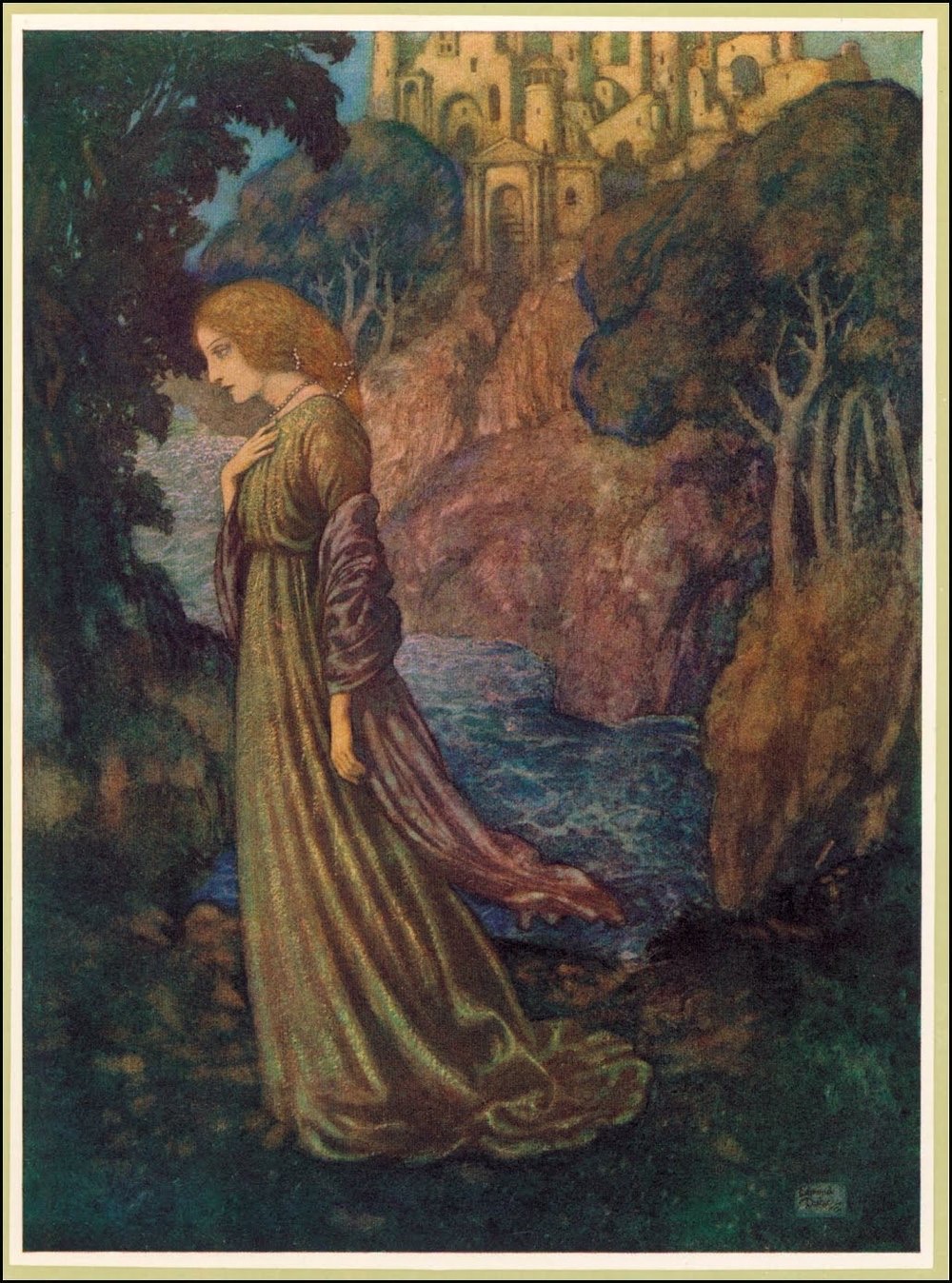
Courtesy: Poe, Edgar Allan. (Jan 5, 2016). The Bells and Other Poems. Project Gutenberg (Public Domain). Retrieved March 10, 2023, from https://www.gutenberg.org/files/50852/50852-h/50852-h.htm
To view more art work by Edmund Dulac, please open the link here.
“Annabel Lee” by Edgar Allan Poe
It was many and many a year ago,
In a kingdom by the sea,
That a maiden there lived whom you may know
By the name of Annabel Lee;
And this maiden she lived with no other thought
Than to love and be loved by me.
I was a child and she was a child,
In this kingdom by the sea;
But we loved with a love which was more than love—
I and my Annabel Lee;
With a love that the wingèd seraphs of heaven
Coveted her and me.
And this was the reason that, long ago,
In this kingdom by the sea,
A wind blew out of a cloud, chilling
My beautiful Annabel Lee;
So that her highborn kinsmen came
And bore her away from me,
To shut her up in a sepulchre
In this kingdom by the sea.
The angels, not half so happy in heaven,
Went envying her and me—
Yes!—that was the reason (as all men know,
In this kingdom by the sea)
That the wind came out of the cloud by night,
Chilling and killing my Annabel Lee.
But our love it was stronger by far than the love
Of those who were older than we—
Of many far wiser than we—
And neither the angels in heaven above,
Nor the demons down under the sea,
Can ever dissever my soul from the soul
Of the beautiful Annabel Lee.
For the moon never beams without bringing me dreams
Of the beautiful Annabel Lee;
And the stars never rise but I feel the bright eyes
Of the beautiful Annabel Lee;
And so, all the night-tide, I lie down by the side
Of my darling—my darling—my life and my bride,
In her sepulchre there by the sea,
In her tomb by the sounding sea.
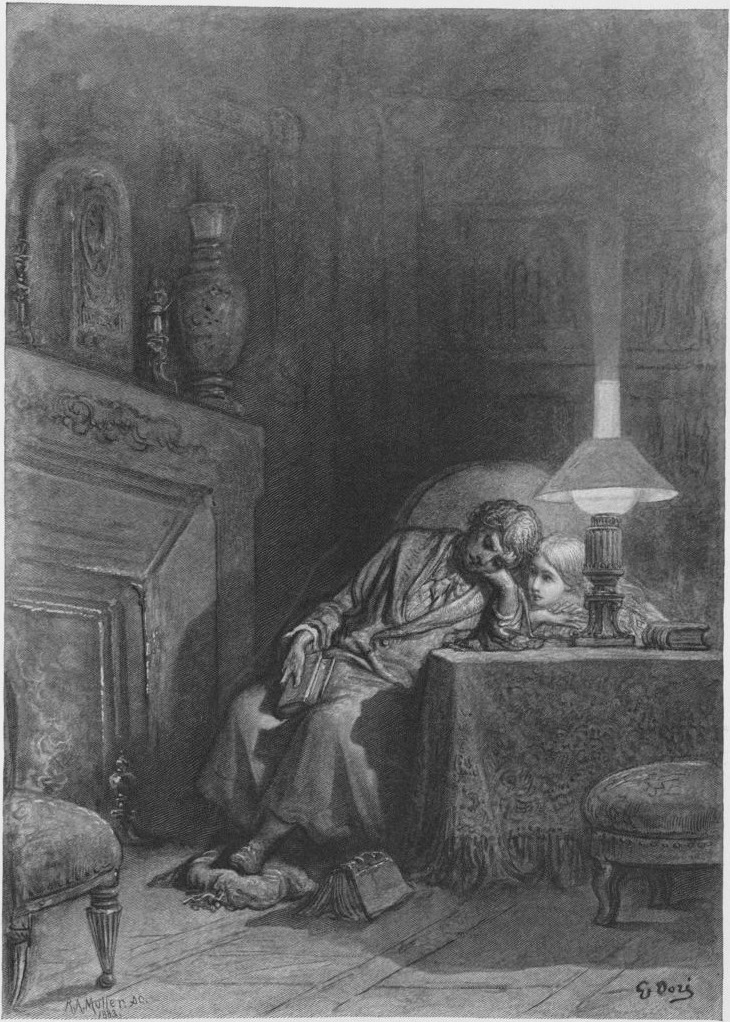
Courtesy: By Gustave Doré – childrenslibrary.org, Public Domain, https://commons.wikimedia.org/w/index.php?curid=26268844
“Once upon a midnight dreary, while I pondered, weak and weary,
Over many a quaint and curious volume of forgotten lore.”-E.A. Poe (from “The Raven”, p. 28, Project Gutenberg). https://www.gutenberg.org/cache/epub/17192/pg17192-images.html
To view the complete illustrations of Gustave Dore for “The Raven” please open the Project Gutenberg link below. https://www.gutenberg.org/files/17192/17192-h/17192-h.htm
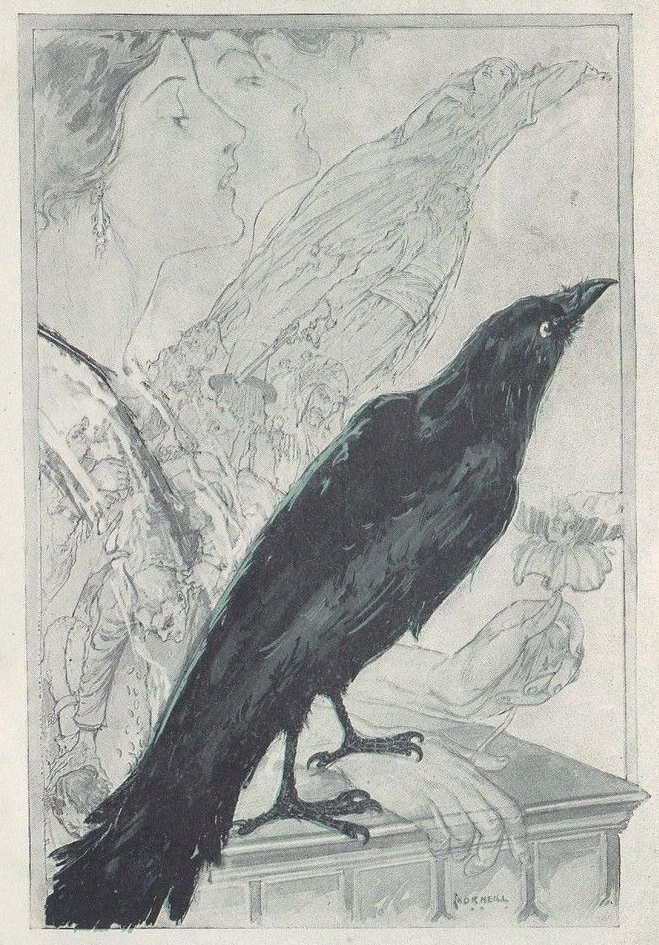
Courtesy: By John R. Neill – “The Raven and other Poems”. Drawings by John Rea Neill (1910), Public Domain, https://commons.wikimedia.org/w/index.php?curid=41226564
Excerpt from The Raven by Edgar Allan Poe (1809-1849)
Once upon a midnight dreary, while I pondered, weak and weary,
Over many a quaint and curious volume of forgotten lore,
While I nodded, nearly napping, suddenly there came a tapping,
As of some one gently rapping, rapping at my chamber door.
“‘Tis some visitor,” I muttered, “tapping at my chamber door-
Only this, and nothing more.”
Ah, distinctly I remember it was in the bleak December,
And each separate dying ember wrought its ghost upon the floor.
Eagerly I wished the morrow;- vainly I had sought to borrow
From my books surcease of sorrow- sorrow for the lost Lenore-
For the rare and radiant maiden whom the angels name Lenore-
Nameless here for evermore.
And the silken sad uncertain rustling of each purple curtain
Thrilled me- filled me with fantastic terrors never felt before;
So that now, to still the beating of my heart, I stood repeating,
“‘Tis some visitor entreating entrance at my chamber door-
Some late visitor entreating entrance at my chamber door;-
This it is, and nothing more.”
Presently my soul grew stronger; hesitating then no longer,
“Sir,” said I, “or Madam, truly your forgiveness I implore;
But the fact is I was napping, and so gently you came rapping,
And so faintly you came tapping, tapping at my chamber door,
That I scarce was sure I heard you”- here I opened wide the door;-
Darkness there, and nothing more.
Deep into that darkness peering, long I stood there wondering,
fearing,
Doubting, dreaming dreams no mortals ever dared to dream before;
But the silence was unbroken, and the stillness gave no token,
And the only word there spoken was the whispered word, “Lenore!”
This I whispered, and an echo murmured back the word, “Lenore!”-
Merely this, and nothing more.
Back into the chamber turning, all my soul within me burning,
Soon again I heard a tapping somewhat louder than before.
“Surely,” said I, “surely that is something at my window lattice:
Let me see, then, what thereat is, and this mystery explore-
Let my heart be still a moment and this mystery explore;-
‘Tis the wind and nothing more.”
Open here I flung the shutter, when, with many a flirt and
flutter,
In there stepped a stately raven of the saintly days of yore;
Not the least obeisance made he; not a minute stopped or stayed
he;
But, with mien of lord or lady, perched above my chamber door-
Perched upon a bust of Pallas just above my chamber door-
Perched, and sat, and nothing more.
Then this ebony bird beguiling my sad fancy into smiling,
By the grave and stern decorum of the countenance it wore.
“Though thy crest be shorn and shaven, thou,” I said, “art sure no
craven,
Ghastly grim and ancient raven wandering from the Nightly shore-
Tell me what thy lordly name is on the Night’s Plutonian shore!”
Quoth the Raven, “Nevermore.”
Much I marvelled this ungainly fowl to hear discourse so plainly,
Though its answer little meaning- little relevancy bore;
For we cannot help agreeing that no living human being
Ever yet was blest with seeing bird above his chamber door-
Bird or beast upon the sculptured bust above his chamber door,
With such name as “Nevermore.”
But the raven, sitting lonely on the placid bust, spoke only
That one word, as if his soul in that one word he did outpour.
Nothing further then he uttered- not a feather then he fluttered-
Till I scarcely more than muttered, “other friends have flown
before-
On the morrow he will leave me, as my hopes have flown before.”
Then the bird said, “Nevermore”…..
(For the complete poem, please open the link below: https://allpoetry.com/poem/8448403-The-Raven-by-Edgar-Allan-Poe.)
Excerpt from “The Highwayman” by Alfred Noyes
PART ONE
The wind was a torrent of darkness among the gusty trees,
The moon was a ghostly galleon tossed upon cloudy seas,
The road was a ribbon of moonlight over the purple moor,
And the highwayman came riding—
Riding—riding—
The highwayman came riding, up to the old inn-door.
He’d a French cocked-hat on his forehead, a bunch of lace at his chin,
A coat of the claret velvet, and breeches of brown doe-skin;
They fitted with never a wrinkle: his boots were up to the thigh!
And he rode with a jewelled twinkle,
His pistol butts a-twinkle,
His rapier hilt a-twinkle, under the jewelled sky.
Over the cobbles he clattered and clashed in the dark inn-yard,
And he tapped with his whip on the shutters, but all was locked and barred;
He whistled a tune to the window, and who should be waiting there
But the landlord’s black-eyed daughter,
Bess, the landlord’s daughter,
Plaiting a dark red love-knot into her long black hair.
And dark in the dark old inn-yard a stable-wicket creaked
Where Tim the ostler listened; his face was white and peaked;
His eyes were hollows of madness, his hair like mouldy hay,
But he loved the landlord’s daughter,
The landlord’s red-lipped daughter,
Dumb as a dog he listened, and he heard the robber say
“One kiss, my bonny sweetheart, I’m after a prize to-night,
But I shall be back with the yellow gold before the morning light;
Yet, if they press me sharply, and harry me through the day,
Then look for me by moonlight,
Watch for me by moonlight,
I’ll come to thee by moonlight, though hell should bar the way.”
(For the complete verses of “The Highwayman” please open the link below:
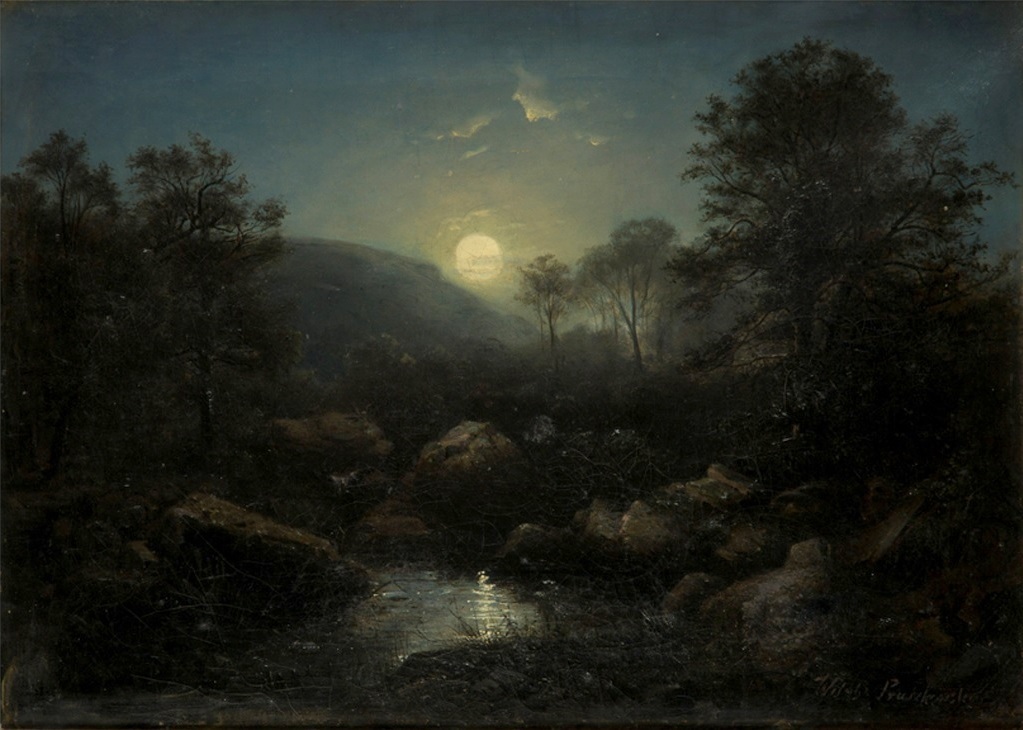
Courtesy: By Witold Pruszkowski – muzeum.bytom.pl, Public Domain, https://commons.wikimedia.org/w/index.php?curid=120858824
“The Kelpie Riders” by Bliss Carman
I
Buried alive in calm Rochelle,
Six in a row by a crystal well,
All Summer long on Bareau Fen
Slumber and sleep the Kelpie men;
By the side of each to cheer his ghost,
A flagon of foam with a crumpet of frost.
Hear me, friends, for the years are fleet;
Soon I leave the noise and the street
For the silent uncompanioned way
Where the inn is cold and the night is gray.
But noon is warm and the world is still
Where the Kelpie riders have their will.
For never a wind dare stir or stray
Over those marshes salt and gray;
No bit of shade as big as your hand
To traverse or trammel the sleeping land,
Save where a dozen poplars fleck
The long gray grass and the well’s blue beck.
Yet you mark their leaves are blanched and sear,
Whispering daft at a nameless fear.
While round the hole of one is a rune,
Black in the wash of the bleaching noon.
“Ride, for the wind is awake and away.
Sleep, for the harvest grain is gray.”
No word more. And many a mile,
A ghostly bivouac rank and file,
They sleep to-day on the marshes wide;
Some far night they will wake and ride.
Once they were riders hot with speed,
“Kelpie, Kelpie, gallop at need!”
To read more poems based on folklore and the sea by Bliss Carman please open the link here.
Ballads of Lost Haven: A Book of the Sea by Bliss Carman (1861 – 1929)
Ballads of Lost Haven (Bliss Carman).
To learn more about Kelpies, please open the link here.
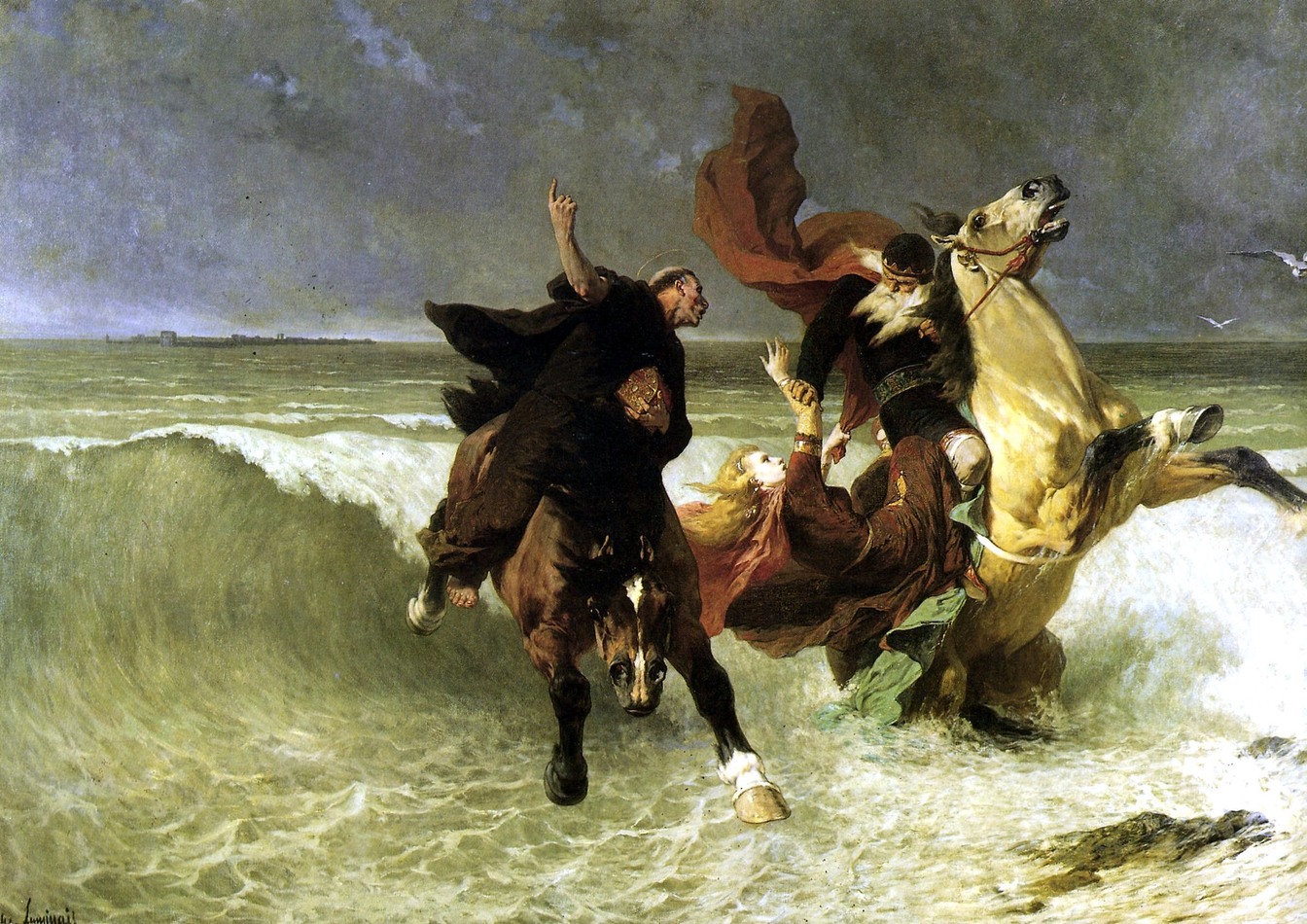
Courtesy: By Évariste Vital Luminais – 1.- 3. Musée des beaux-arts de Quimper4. matricien.org, Public Domain, https://commons.wikimedia.org/w/index.php?curid=4035963
Versions of Kelpies in Art
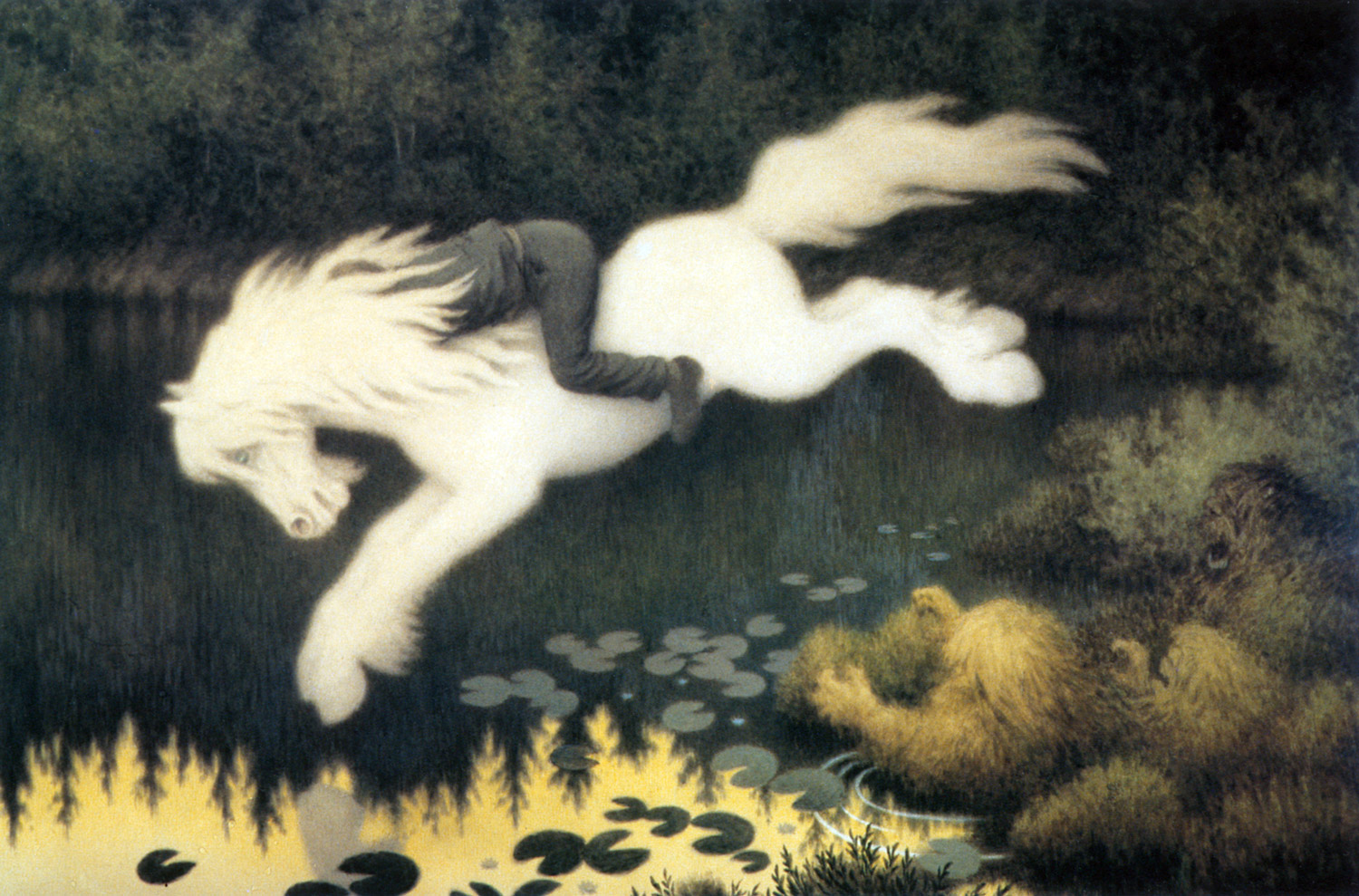
Courtesy: By Theodor Kittelsen – http://www.museumsnett.no/nordnorsk-kunstmuseum/Kittelsen.htm, Public Domain, https://commons.wikimedia.org/w/index.php?curid=802448
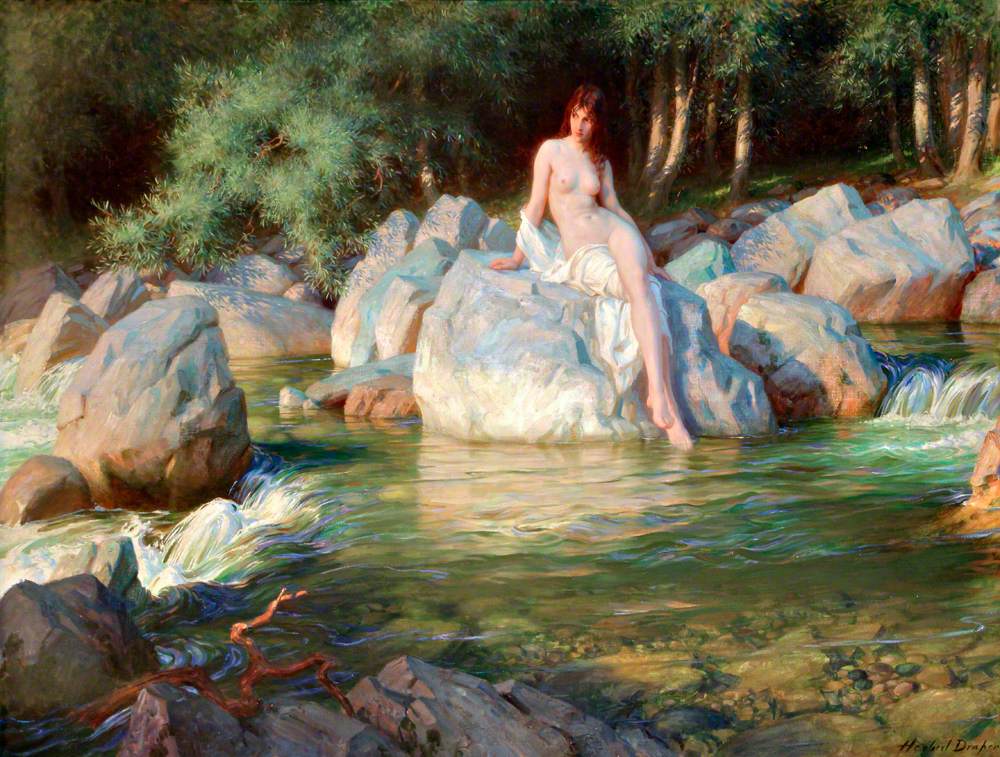
Conflict and War: Essential Questions
In viewing the images and poems about war, you might reflect on the following questions.
- 1How and why do wars start?
- How are individuals changed physically, cognitively, and emotionally because of war? How are families, communities, and natural landscape impacted by war?
- What are the moral costs of war?
- How do wars influence world events and the history of people?
- What differentiates one nation’s identity from another?
- What role does technology play in war and conflict?
- To what extent do conceptions of human rights and social justice change across time and cultural epochs?
- Can conflict and war be prevented? How?
- How do we create cultures and pathways of peace?
- What do war poets communicate through their poems?
- How do different artists portray war?
- What should be the responsibility of each person to prevent war and create a pathway for peace?
Essential Questions:
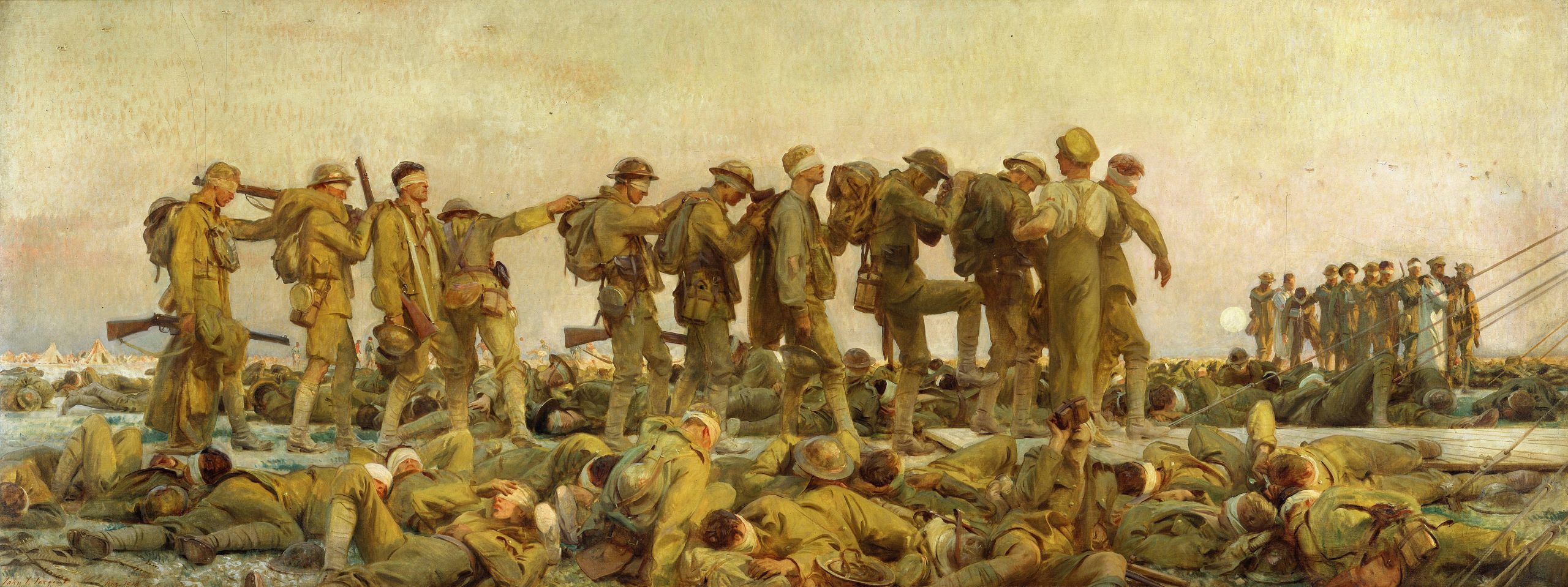
Courtesy: By John Singer Sargent – ygEoGPGLZRQzeg at Google Cultural Institute maximum zoom level, Public Domain, https://commons.wikimedia.org/w/index.php?curid=21924578
“Dulce et Decorum Est” by Wilfred Owen
Bent double, like old beggars under sacks,
Knock-kneed, coughing like hags, we cursed through sludge,
Till on the haunting flares we turned our backs,
And towards our distant rest began to trudge.
Men marched asleep. Many had lost their boots,
But limped on, blood-shod. All went lame, all blind;
Drunk with fatigue; deaf even to the hoots
Of gas-shells dropping softly behind.
Gas! GAS! Quick, boys!—An ecstasy of fumbling
Fitting the clumsy helmets just in time,
But someone still was yelling out and stumbling
And flound’ring like a man in fire or lime.—
Dim through the misty panes and thick green light,
As under a green sea, I saw him drowning.
In all my dreams before my helpless sight
He plunges at me, guttering, choking, drowning.
If in some smothering dreams, you too could pace
Behind the wagon that we flung him in,
And watch the white eyes writhing in his face,
His hanging face, like a devil’s sick of sin,
If you could hear, at every jolt, the blood
Come gargling from the froth-corrupted lungs,
Obscene as cancer,
Bitter[1] as the cud
Of vile, incurable sores on innocent tongues,–
My friend, you would not tell with such high zest
To children ardent for some desperate glory,
The old Lie: Dulce et decorum est
Pro patria mori.[2]
*Meaning: How sweet and fitting it is to die for one’s country.
Wilfred Owen (1893-1918) died at age 25 during WWI in 1918. His poem lives on in its powerful message that war can only cause harm and destruction. Innocent lives are lost. His message resonates across historical time periods and cultures.
“Wilfred Owen was killed in action on 4 November 1918 during the crossing of the Sambre–Oise Canal, exactly one week (almost to the hour) before the signing of the Armistice which ended the war, and was promoted to the rank of Lieutenant the day after his death. His mother received the telegram informing her of his death on Armistice Day, as the church bells in Shrewsbury were ringing out in celebration.[9][19] Owen is buried at Ors Communal Cemetery, Ors, in northern France.[20] The inscription on his gravestone, chosen by his mother Susan, is based on a quote from his poetry: “SHALL LIFE RENEW THESE BODIES? OF A TRUTH ALL DEATH WILL HE ANNUL” W.O.[20][21]” (WIkipedia).
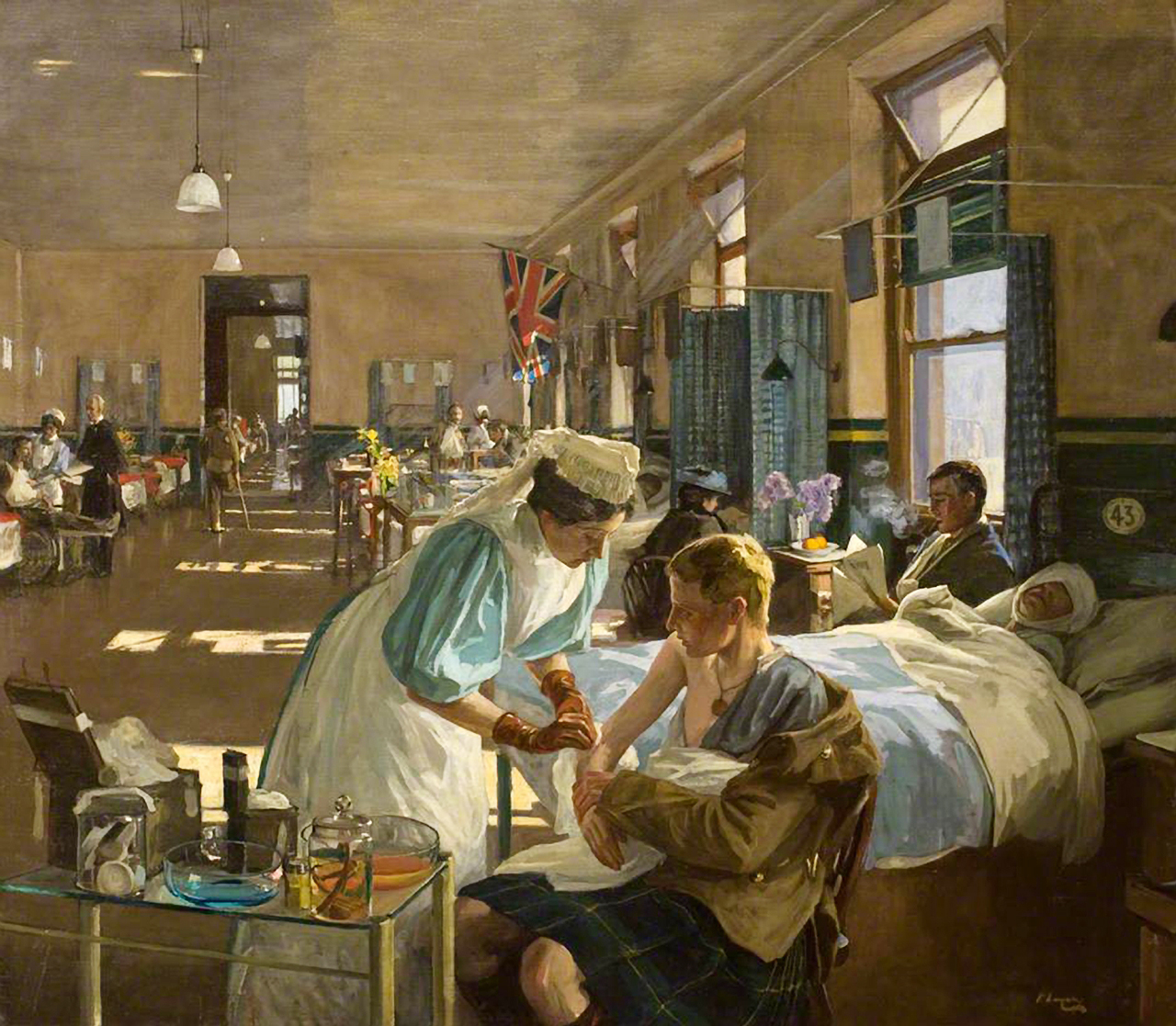
Courtesy: By John Lavery – Sir John Lavery_375, Public Domain, https://commons.wikimedia.org/w/index.php?curid=66975318
To read more about John Lavery’s paintings about war please open the link below.
https://arthistoryunstuffed.com/irish-artists-of-the-great-war/
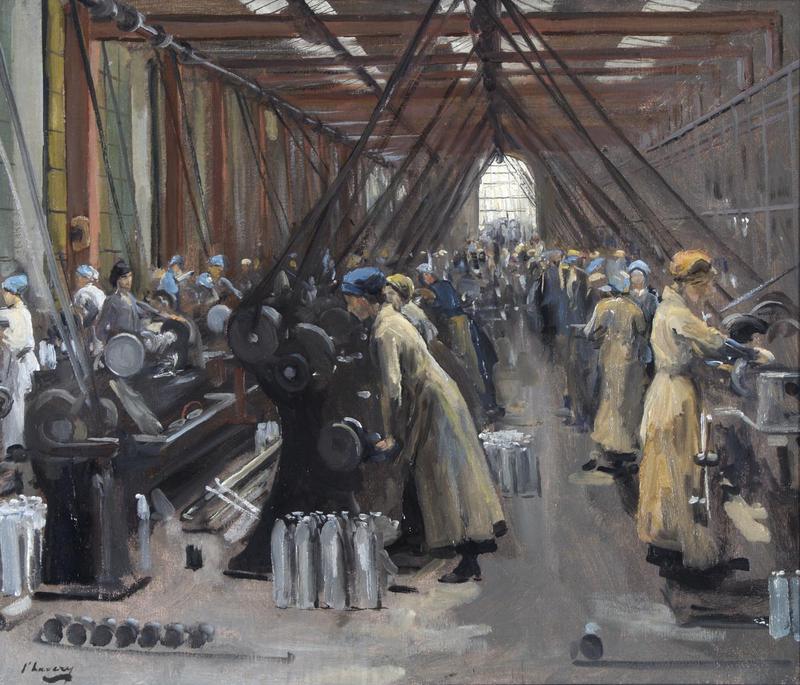
Courtesy: By John Lavery – This photograph Art.IWM ART 4235 comes from the collections of the Imperial War Museums., Public Domain, https://commons.wikimedia.org/w/index.php?curid=30202453
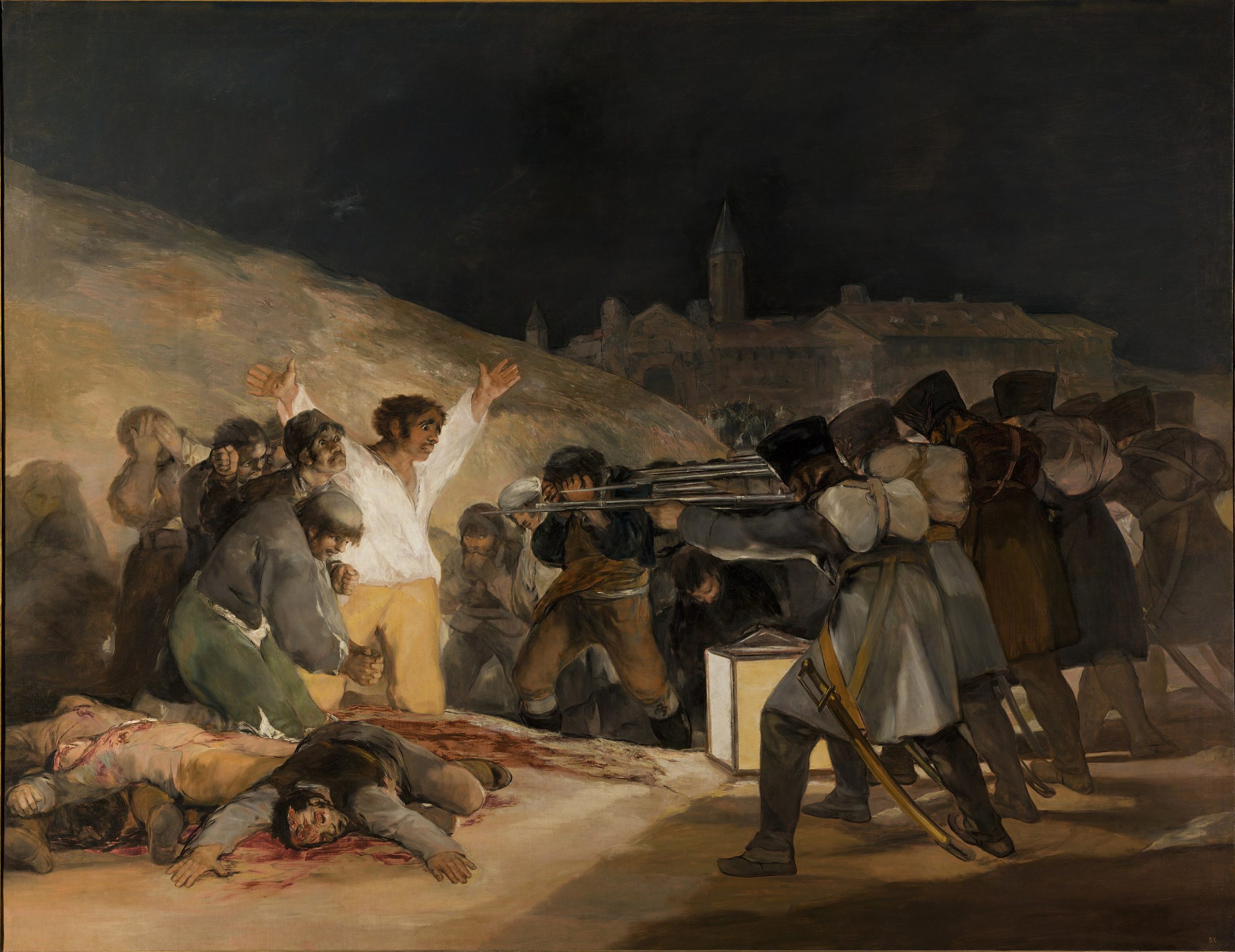
Courtesy: By Francisco de Goya – The Prado in Google Earth: Home – 7th level of zoom, JPEG compression quality: Photoshop 8., Public Domain, https://commons.wikimedia.org/w/index.php?curid=22615690
History about the painting, The Third of May by Goya:
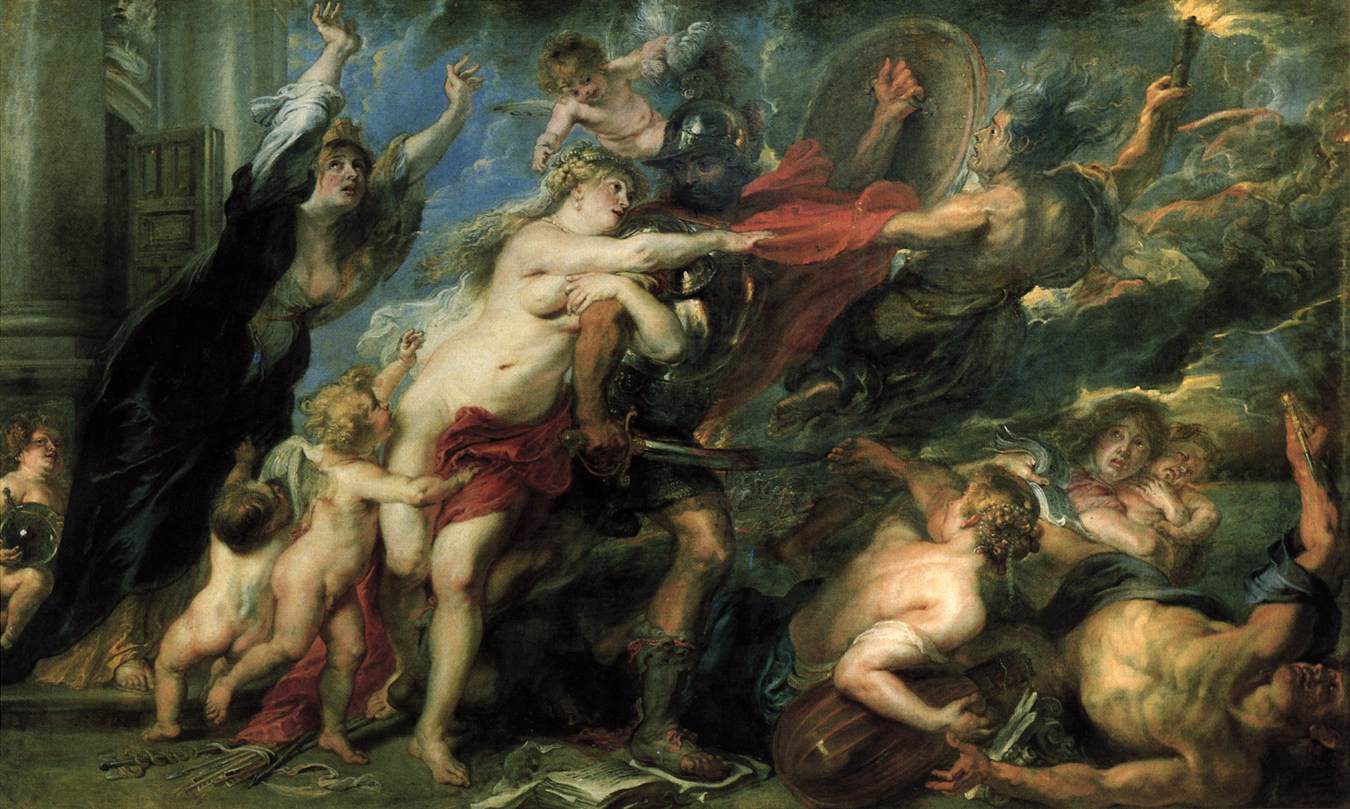
Courtesy: By Peter Paul Rubens – Web Gallery of Art: Image Info about artwork, Public Domain, https://commons.wikimedia.org/w/index.php?curid=5945996
Learning Objectives
Further Research and Inquiry
Research the history of a painting about a particular war/battle/conflict. How does an artist’s portrayal of war and conflict impact your insights into war and conflict? How do poems connected in some way to the theme of a particular art work about war deeper your understanding? Please click on the links below for further information about paintings and poems related to war and conflict.
Create a photo essay or art essay that highlights your vision of peace. You can also integrate peace poems that you find or that you can create.
For additional information please open the links below:

